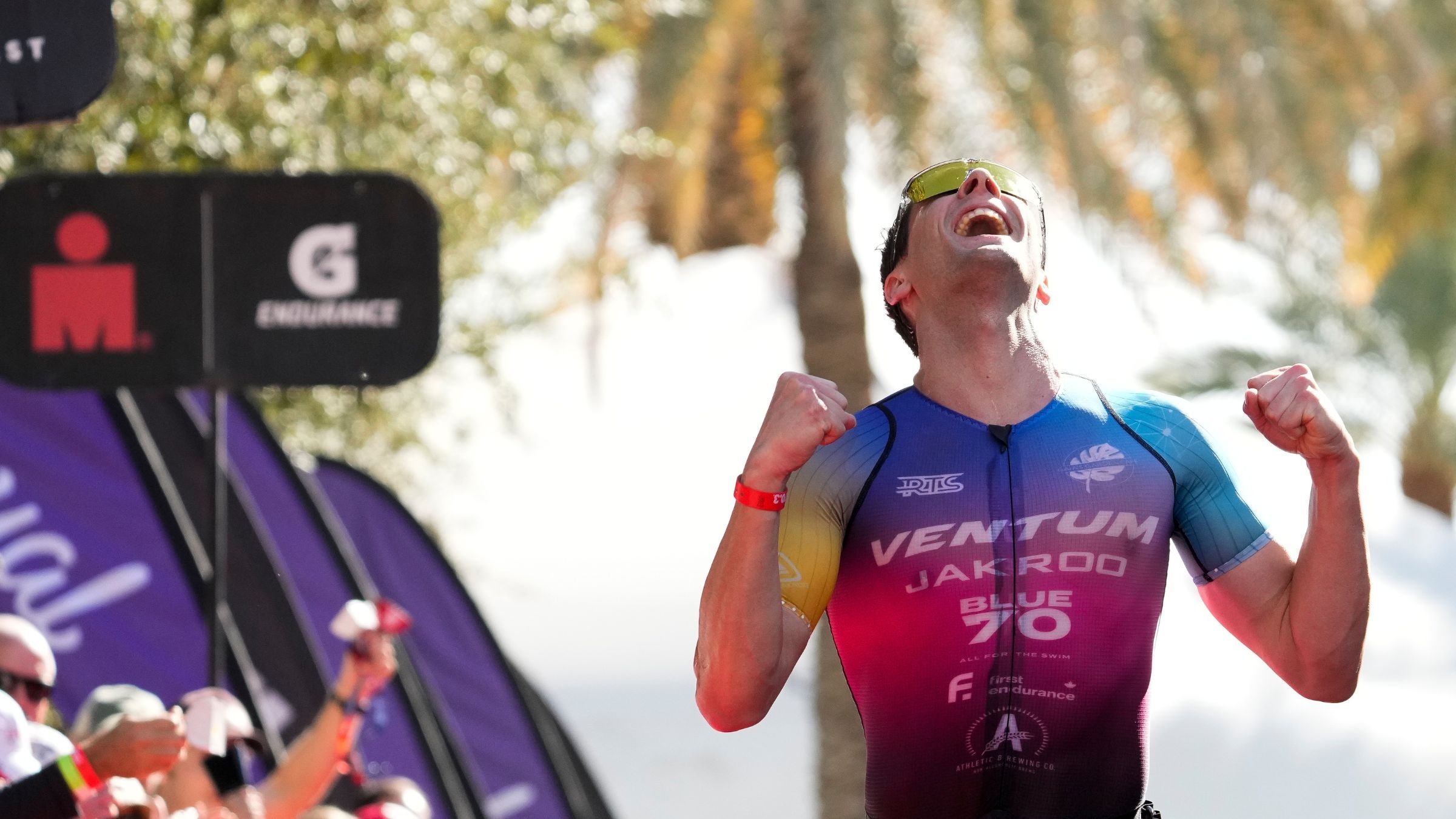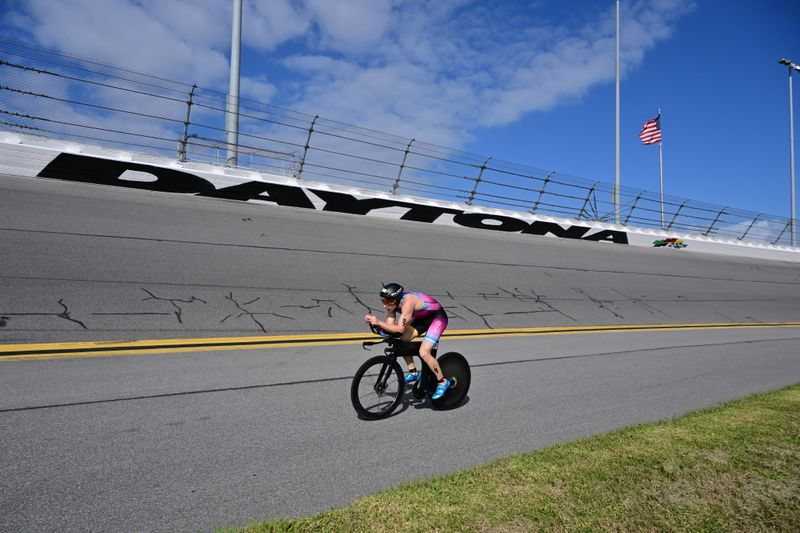How On Earth Did Jackson Laundry Race Two Long-Course Events In One Weekend?

(Photo: Patrick McDermott/Getty Images)
Hands and feet numb from the cold as he exits the water, Jackson Laundry sees Sam “The Big Unit” Long run past in transition.
In this final race of a long year, Long, the popular U.S. triathlete whose season hasn’t gone exactly to plan, isn’t short of motivation.
The Canadian, Laundry, who has had an equally long season, knows his best – perhaps only – chance of success here in Southern California is to stick with the powerhouse cyclist for the next 56 miles. In normal times, that in itself would be no mean feat. Given Laundry has raced less than 48 hours earlier and 2,400 miles due east at the Daytona International Speedway circuit, it makes for an unenviable proposition.
Then there’s the quad soreness. Laundry might have expected to feel it during the latter part of the half-marathon in three hours time, but from the gun in the swim?! “That was a bit concerning,” he reflects. “But I just pushed on…”
Given Laundry rode through the field (with Long) on the bike for a 2:01:42 split, produced a peak two-minute power of 409 watts, opened a gap of four minutes on to the run and then held on for second place, Ironman 70.3 Indian Wells can go down as one of the best performances of his career. And given the circumstances leading in, it also becomes a tale to tell the grandkids, and no doubt one that can be lovingly embellished year-on-year. A crazy goal, admittedly, but one where there was method – and meticulous planning – in the madness.

“I just wanted one more chance.”
“It was the last race weekend of the year in North America, and my fitness was indicative of better performances than I’d shown,” Laundry says, his only victory in 12 races having come with a thrilling finish at Oceanside 70.3 in April. “I just wanted one more chance.”
Well, two to be precise. Laundry knew the course, conditions, and distance in Indian Wells were more suited to his strengths, but equally enjoyed the race experience Clash would provide in Florida, having finished seventh in a strong field in Miami in March. The lure of a $110k prize purse including primes that paid eight deep was also tempting.
As it so happened, Clash’s pro athlete support wasn’t just helpful for the race experience, but instrumental in helping the 29-year-old catch his Friday evening flight from Orlando to Palm Springs.
Over the “Daytona distance”—one-mile swim, 37.5-mile bike and 8.2-mile run—Laundry finished in the money in eighth. Then he really had to get a move on. The race finished at 3:30 p.m. and his flight was scheduled for 6:45 p.m. It was an 80-minute drive to the airport.
“I did the math and figured I had to leave with all my stuff by 4:20 p.m.,” he says. “I was able to get the race mechanic to take my bike apart and bag it while I was running. Then another friend, Lesley, gathered all my stuff, and my car was parked 100 yards from the finish line. Had I been in the top five it would’ve been tougher because of the awards presentation, but I still figured I’d be ok.”
In eventuality, the flight was delayed 25-minutes and Laundry – in full recovery mode – was able to make headway munching the 4,000 plus calories he’d consumed before reaching the AirBnB in Palm Springs late into the night. “When you do something like this, the things that can mess you up are muscle soreness, and if you deplete yourself your whole body feels off and you’re in a survival state,” Laundry says. “A lot of time after races I don’t feel hungry and don’t recover as well, but this time I forced myself to eat and even though I was really sore, I knew the biggest thing would be to replenish my energy and recover.
RELATED: Got Sore Muscles? It Might Be Your Diet
“I didn’t sleep that much on Friday, but on Saturday I got a great night’s rest and even though I had to wake up at 4 a.m. for the race, it felt like 7 a.m. as I’d come from east coast time. I was then just praying I wouldn’t cramp during the race and would have to push through the muscle soreness.”
The decision to fly on Friday rather than stay in Florida was also part of the plan. “I knew race-day in Daytona would be stressful on the body no matter what, so I decided to make that my one ‘disaster day’. It meant I could recover again Saturday and when I looked at the week in its entirety it’s just one day that was hard on the body.”
While Laundry enjoys the Clash racing, he’s under no illusions that the format doesn’t suit his strengths – especially when the elite field from World Triathlon draft-legal races show up.
“l had what I honestly felt was a good swim and was almost two-and-a-half minutes down. Then instead of an 80-90km bike to work with, I had 60km. I was starting to put time into the field and got myself up to sixth place, but add another 20-30km on to the bike and the race looks different.”
Double the racing, double the fun
Lining up in Indian Wells without expectation, Laundry knew the regular Ironman 70.3 distance of 1.2-mile swim, 56-mile bike leg and 13.1-mile run was more favorable, as were the conditions. The air temperature was a chilly 47°F (8°C) and water 57°F (14°C), something Laundry was more than acclimated to coming from Guelph, Ontario where when pools had been closed during the pandemic he’d regularly take to the lakes to swim.
“I was in a good space mentally, thinking if it goes t*** up then who cares?! I swam ok, but could feel my legs were sore. You don’t typically feel quad soreness while swimming so that was a bit concerning, but I just pushed on and tried to keep the effort relatively low.
“I got out of the water and Sam Long ran past me straight away – he had a fantastic swim. I decided there and then I was going to try to ride with him no matter what. My legs were incredibly stiff at the start of the bike and it took a minute or two to get over it mentally and just push through. We started hauling to catch the leaders.”
From there the duo pushed on. Laundry produced a peak 10-minute power effort and the resistance eventually broke as they arrived in T2 with a four-minute buffer over Lionel Sanders, Bert Aernouts, and Justin Riele. Laundry says the bike leg in Indian Wells was at least on a par with anything he had produced previously, but he still had to run.
“My quads were taking a pounding,” he adds. “I didn’t totally give up as Sam wasn’t pulling away really fast, but I started thinking about protecting second place. I knew from Lionel’s run in Oceanside he could definitely close in the last couple of miles.”
Jackson’s tips on tapering for a big weekend of racing
“Everyone is different, but I find people do too much training in the week of the race.
“You’re already traveling to the event and want your body to feel like it’s repaired, healthy and rested.
“It doesn’t take much to stay activated and you don’t want to be introducing any type of fatigue.
“Don’t be afraid to take in lots of carbs pre race. You should probably be heavier on the startline because your body should be topped up with glycogen and well hydrated to give you the energy to perform.
“Every year for the past decade, I’ve gained an average of a pound a year and gone faster every year. When I was high level age-group racing I was 143 pounds, now I’m 153 pounds.
“Part of the sport is getting healthy and for a lot of people that means losing a little bit of weight, but don’t restrict your diet during race week.”
Where Jackson looks to improve
“Thanks largely to the PTO, more World Triathlon athletes are seeing an opportunity to try longer-course racing, and when Henri Schoeman and Vincent Luis step up it’s a different level.
“My swimming has stagnated for the past 7-8 years and I want to improve it. I’m going to talk to my coach, find mentors, do some research, perhaps get more on deck coaching, and find out what kind of stimulus I can add.
“I want to find ways to get better propulsion. I have pretty good form, but a lot of guys are getting speed from their kick as well and that’s something I’ve never worked on. I want to build it into a point where it becomes normal and won’t take away from my running or biking.”
RELATED: How Jackson Laundry Surprised A Double Gold Medalist And The Tri World